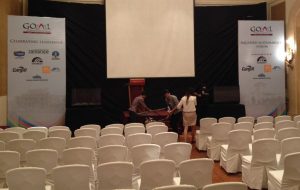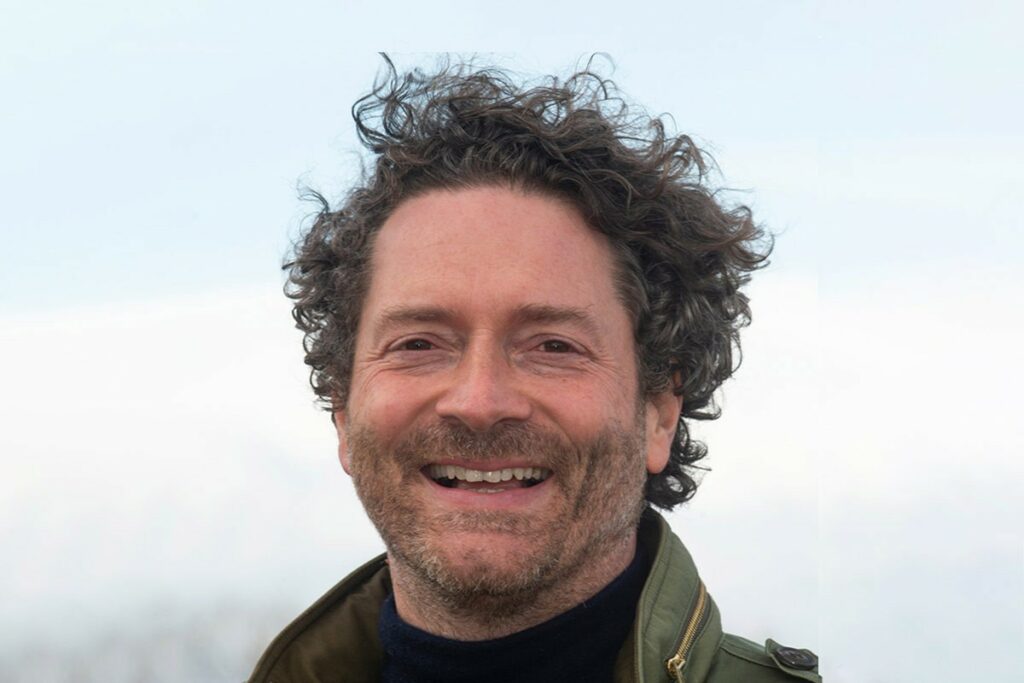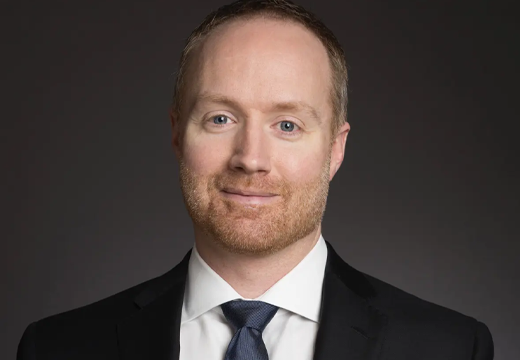GOAL 2014 Blog: Greetings From Vietnam
Friday, Oct. 10, 5:00 p.m.—GAA, IFFO, Lyons Seafoods Co. and Wm Morrison Supermarkets have collectively agreed to a position statement on the social concerns related to aqua feed production. The announcement came on the final day of GAA’s GOAL 2014 conference in Ho Chi Minh City, Vietnam.
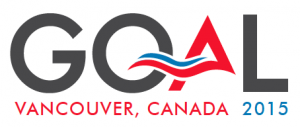 Thursday, Oct. 10, 12:55 p.m.—See you in Vancouver in 2015!
Thursday, Oct. 10, 12:55 p.m.—See you in Vancouver in 2015!
Travis Larkin of The Seafood Exchange (pictured below) made the announcement—and unveiled the GOAL 2015 logo—during his closing remarks at GOAL 2014.
This is the first time that the GOAL conference will be held in Canada, and this is the first time in six years that the GOAL conference will be held in North America, where GOAL 2009 took place in Seattle, Washington, USA.
The dates and venue will be announced in November. Once the dates and venue are determined, registration will open, with a special rate offered to delegates who register early. Please check the GAA website and e-newsletter regularly for more information on GOAL 2015.
Hope to see you in Canada next year!
Thursday, Oct. 10, 12:35 p.m.—A big thanks to all GOAL 2014 sponsors, especially co-hosts National Fish & Seafood and the Vietnam Ministry of Agriculture and Rural Development!
Thursday, Oct. 10, 12:30 p.m.—As GOAL 2014 wrapped up, moderator Peter Redmond, using the automatic response system, again threw out the question, “What is the most important challenge limiting aquaculture?” The question was also posed on Day 1. Here are results, the beginning of the four-day conference compared to the end.
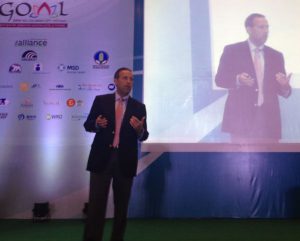 Day 1: What is the most important challenge limiting aquaculture?
Day 1: What is the most important challenge limiting aquaculture?
Health and disease management — 48%
Feed — 9%
Environmental and social responsibility — 11%
Investment capital — 9%
Market support — 4%
Leadership — 6%
Consumer education — 13%
Day 3: What is the most important challenge limiting aquaculture?
Health and disease management — 63%
Feed — 4%
Environmental and social responsibility — 11%
Investment capital — 9%
Market support — 1%
Leadership — 5%
Consumer education — 7%
Thursday, Oct. 10, 11:45 a.m.—The fourth and final roundtable—featuring Julian Mahieu of Delhaize Group, Josanna Busby of Delhaize America, Robert Fields of Sam’s Club, Charlotte Maddocks of Tesco and Wendy Norden of Monterey Bay Aquarium—is on the stage.
Again, the subject of early mortality syndrome—and its impact on shrimp sourcing—popped up. Scroll down for a recap of Day 1, which focused on disease management.
“Our sourcing strategy is already based on concerns like disease and natural disasters,” said Maddocks. “EMS highlighted how vulnerable intensive production can be. We need to drill down and identify what the best practices are and ensure that they’re implemented—and it has to be everyone.”
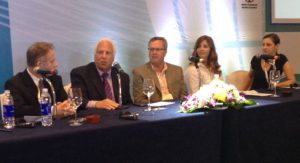 Thursday, Oct. 10, 11:00 a.m.—Next up are Maisie Ganzler of Bon Appetit Management Co./Compass Group, David Wier of Meijer, Laky Zeraduchi of Seafood Direct, Kathleen Mullen-Ley of FishWise and Jeff Sedacca of National Fish & Seafood, in the third of four roundtables.
Thursday, Oct. 10, 11:00 a.m.—Next up are Maisie Ganzler of Bon Appetit Management Co./Compass Group, David Wier of Meijer, Laky Zeraduchi of Seafood Direct, Kathleen Mullen-Ley of FishWise and Jeff Sedacca of National Fish & Seafood, in the third of four roundtables.
Again, social welfare—particularly the employment of forced labor in so-called trash fisheries in Southeast Asia that the U.K.’s Guardian newspaper brought to light four months ago—dominated the discussion.
It’s a gray area, and the panelists talked about the various way to prevent human trafficking in fisheries and aquaculture.
“Governments have an important role to play. We have to be able to get through to the governments of those countries to express our despair and tell them that these issues can’t go on,” said Zeraduchi.
Added Sedacca: “The problem is fragmentation in the supply chain and transparency. We need to develop mechanisms to look back down the supply chain. The first step is to develop that transparency.”
Sedacca, a GAA board member, applauded the Best Aquaculture Practices third-party certification program for its comprehensiveness (social responsibility is among the components of the program).
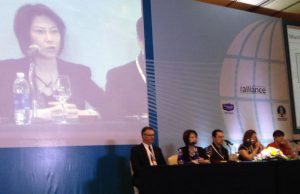 Friday, Oct. 10, 9:45 a.m.—Bill DiMento of High Liner Foods, Jackie Healing of Coles, Dawn Purchase of the Marine Conservation Society, Scott Williams of B.J.’s Wholesale Club and Marie Zhang of Long John Silver’s are on the stage, in the second of four roundtables.
Friday, Oct. 10, 9:45 a.m.—Bill DiMento of High Liner Foods, Jackie Healing of Coles, Dawn Purchase of the Marine Conservation Society, Scott Williams of B.J.’s Wholesale Club and Marie Zhang of Long John Silver’s are on the stage, in the second of four roundtables.
Moderator Peter Redmond kicked off the panel with a question on social welfare and the challenge of preventing human trafficking in fisheries.
“The first and most important thing is to be aware of the situation that you’re facing,” said Healing. “You need to be aware. And then you need to take a whole chain approach. You need to be as honest and open as you can without fear of retribution. Understanding the situation is 80 percent of the solution. Transparency is the most important thing.”
“Social issues will [require more attention] than environmental issues over the next two years,” added Zhang.
The panelists were also asked about consumer education, which GAA Executive Director Wally Stevens identified as the seventh major challenge facing aquaculture. Scroll down for a recap of Day 1.
In the United States, Williams talked about the importance of reaching Millennials or Generation Y, those born between the early 1980s and the early 2000s, and their expectation that the products they buy are produced in a responsible manner — 100 percent of the time. “In five or 10 years, we’re not going to get credit for that. It will be an expectation,” said Williams.
“Consumers expect retailers to be good stewards on their behalf,” added Purchase.
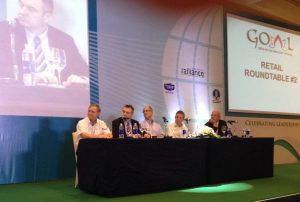 Friday, Oct. 10, 9:00 a.m.—The first of four roundtables featuring the world’s leading seafood retailers, foodservice operators and suppliers — moderated by Peter Redmond of Best Aquaculture Practices — is under way.
Friday, Oct. 10, 9:00 a.m.—The first of four roundtables featuring the world’s leading seafood retailers, foodservice operators and suppliers — moderated by Peter Redmond of Best Aquaculture Practices — is under way.
The five panelists were asked about traceability, social welfare, early mortality syndrome in shrimp, zone management and smallholder engagement.
“We have seen developments,” said Mike Berthet of M & J Seafood Ltd./Brakes Group, when asked about engaging small-scale farmers and the need to involve them more in the sustainability movement. “Unfortunately, some industries in some countries have not been able to move at the same pace that the market wants them to move, despite us working with the governments. If they don’t comply with some third-party audit, eventually we will have to move away from those countries.”
“The key is organization of the supply chain. Farmers can come together if there’s a structure in place,” added Ally Dingwall of Sainsbury’s. “There’s a market willingness to move forward on this.”
In addition to Berthet and Dingwall, Rich Castle of Giant Eagle, Anton Immink of the Sustainable Fisheries Partnership and Jean-Louis Meuric of Davigel/Nestlé were on the panel.
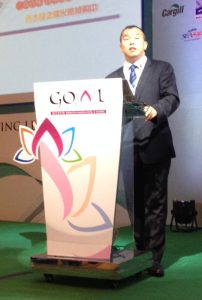 Friday, Oct. 10, 8:00 a.m.—”What do China and its 1.3 billion consumers really want?” That’s one of the questions that Zhu Changliang, CEO of Wuhan Lanesync Supply Chain Management Co. Ltd., posed in his 30-minute presentation at the start of Day 3 of GOAL 2014.
Friday, Oct. 10, 8:00 a.m.—”What do China and its 1.3 billion consumers really want?” That’s one of the questions that Zhu Changliang, CEO of Wuhan Lanesync Supply Chain Management Co. Ltd., posed in his 30-minute presentation at the start of Day 3 of GOAL 2014.
To no surprise, food safety is No. 1. “The consumers have to understand that your product is safe,” Zhu said through a translator.
Chinese consumers also want trustworthy brands, excellent communication and customer services, R & D and new product development, and stable supplies and prices, he said.
In terms of strategies for development, Zhu recommended that foreign suppliers define a long-term plan for the Chinese market, emphasize branding (as it’s the only way to achieve sustainable growth), understand the cultural differences within China and find the right partner to accelerate growth in the Chinese market.
Wuhan Lanesync handles purchasing, distribution, logistics, marketing, processing and other activities for thousands of restaurants and hotels throughout China. In addition, it operates more than 200 Xianzhilong retail outlets and seven warehouses. Zhu has more than 20 years of experience in seafood and foodservice in China, starting his company from scratch.
Friday, Oct. 10, 7:45 a.m.—A big thanks to all GOAL 2014 delegates for attending!
Via the conference’s audience response system, here’s a snapshot of the GOAL 2014 audience. On Day 1, the audience was also asked, “What is the most important challenge limiting aquaculture?”
In what sector of the seafood business do you operate?
Producer (hatchery, farm, processing) — 13%
Supplier (feed, equipment, services) — 8%
Buyer (retail, foodservice, distribution) — 41%
Government or Institutional — 6%
Other (finance, academic, NGO) — 32%
In which region do you primarily do business?
Asia and Australia — 26%
Europe — 16%
North America — 53%
Central and South America — 4%
Africa — 2%
What is the most important challenge limiting aquaculture?
Health and disease management — 48%
Feed — 9%
Environmental and social responsibility — 11%
Investment capital — 9%
Market support — 4%
Leadership — 6%
Consumer education — 13%
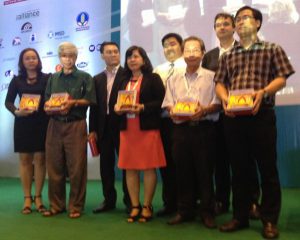 Thursday, Oct. 9, 2:30 p.m. —This afternoon’s Celebrating Leadership in Vietnam’s Aquaculture Industry seminar was quite a success. The program featured Dr. Pham Anh Tuan of the Vietnam Ministry of Agriculture and Rural Development, Dr. Loc H. Tran of Minh Phu AquaMekong ShrimpVet Laboratory, Dr. Le Luu of the International Collaborating Centre for Aquaculture and Fisheries Sustainability (ICAFIS), Mr. Dang Cong Buu of the Integrated Coastal Management Programme (ICMP)/GIZ Vietnam, Dr. Flavio Corsin of IDH, Mr. Ngo Tien Chuong of WWF Vietnam, Mrs. Thi Thanh Binh of Best Aquaculture Practices, Mr. Nguyen Hoai Nam of the Vietnam Association of Seafood Exporters and Producers and Ms. Vo Thi Thu Huong of the Vietnam Pangasius Association.
Thursday, Oct. 9, 2:30 p.m. —This afternoon’s Celebrating Leadership in Vietnam’s Aquaculture Industry seminar was quite a success. The program featured Dr. Pham Anh Tuan of the Vietnam Ministry of Agriculture and Rural Development, Dr. Loc H. Tran of Minh Phu AquaMekong ShrimpVet Laboratory, Dr. Le Luu of the International Collaborating Centre for Aquaculture and Fisheries Sustainability (ICAFIS), Mr. Dang Cong Buu of the Integrated Coastal Management Programme (ICMP)/GIZ Vietnam, Dr. Flavio Corsin of IDH, Mr. Ngo Tien Chuong of WWF Vietnam, Mrs. Thi Thanh Binh of Best Aquaculture Practices, Mr. Nguyen Hoai Nam of the Vietnam Association of Seafood Exporters and Producers and Ms. Vo Thi Thu Huong of the Vietnam Pangasius Association.
GAA presented Thuan Phuoc Seafood & Trading Corp. with a “Commitment to Excellence Award” for achieving four-star Best Aquaculture Practices certification. The company is the fifth Vietnamese company and the tenth overall to achieve four-star BAP status, denoting that the company’s shrimp processing plants, farms, hatcheries and feed mills are BAP certified. A VASEP representative accepting the award on Thuan Phuoc’s behalf.
The seminar was organized by Carson Roper, BAP international business development manager, and Peter Redmond, BAP VP of market development.
A big thanks to the seminar’s sponsors—National Fish & Seafood, Grobest, Minh Phu Seafood Corp., GIZ, Australian Aid, Farmers in Transition Fund and IDH.
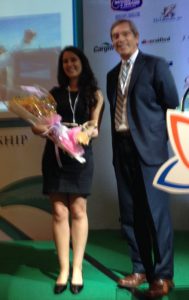 Thursday, Oct. 9, 11:45 a.m.—And the winner is… Rodrigo Prado, a civil engineer and director of Usonic Ltda. in Puerto Montt, Chile, is the winner of the GAA’s Preferred Freezer Services Global Aquaculture Innovation & Leadership Award.
Thursday, Oct. 9, 11:45 a.m.—And the winner is… Rodrigo Prado, a civil engineer and director of Usonic Ltda. in Puerto Montt, Chile, is the winner of the GAA’s Preferred Freezer Services Global Aquaculture Innovation & Leadership Award.
Usonic’s innovation involves the use of ultrasound to control Chilean sea lice (Caligus rogercresseyi) infestations. In numerous trials, the company showed that the application of ultrasound under water, directly in fish pens, has a lethal effect on juvenile stages of sea lice. The application of ultrasound has no effect on salmon or marine mammals due to the low power and frequencies used — only 20 KHz per transmitter.
Accepting the award and giving a presentation on Prado’s behalf was Constanza Alvial (pictured at left), who works with Prado. Alvial was introduced by Dan DiDonato, V.P. of sales and marketing at Preferred Freezer Services, and GAA President George Chamberlain (also pictured at left), who presented her with a plaque and a U.S. $1,000 cash prize.
Congrats to the Usonic team! And thanks to Preferred Freezer Services and the competition’s four judges: Chamberlain, Dan Lee of Best Aquaculture Practices, Michael Tlusty of the New England Aquarium and Dawn Purchase of the Marine Conservation Society.
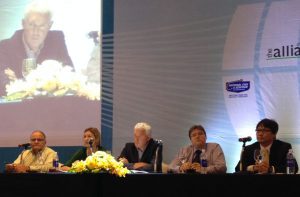 Thursday, Oct. 9, 10:45 a.m.—Peter Redmond of Best Aquaculture Practices is back on the stage after the coffee and tea break, with the first of five roundtables featuring the world’s leading seafood retailers, foodservice operators and suppliers. This roundtable features Patrick Blow of Marks and Spencer, Estelle Brennan of Lyons Seafood Ltd., Carl Salamone of Wegmans Food Markets, Huw Thomas of Morrisons and Joe Zhou of Red Lobster Seafood Co. (There is one roundtable today and two tomorrow.)
Thursday, Oct. 9, 10:45 a.m.—Peter Redmond of Best Aquaculture Practices is back on the stage after the coffee and tea break, with the first of five roundtables featuring the world’s leading seafood retailers, foodservice operators and suppliers. This roundtable features Patrick Blow of Marks and Spencer, Estelle Brennan of Lyons Seafood Ltd., Carl Salamone of Wegmans Food Markets, Huw Thomas of Morrisons and Joe Zhou of Red Lobster Seafood Co. (There is one roundtable today and two tomorrow.)
Redmond’s questions revolved around the subjects addressed at the conference so far, including social welfare and early mortality syndrome (EMS) in shrimp. The impacts of EMS on shrimp sourcing have been significant for retailers and foodservice operators, but the effects on consumer purchasing have been minimal.
“There have been price increases [at the retail level], and [consumers] switched out of shrimp into other species,” said Thomas. “We saw a switch to coldwater prawns, in particular, but they’re coming back [to warmwater prawns] now that prices are falling.”
Salamone had perhaps the most interesting comment on EMS. After attending GOAL 2013 in Paris, France, he shared the outlook on EMS and shrimp sourcing with Wegmans’ public affairs officer, who, in turn, wrote a blog on the U.S. retailer’s website about EMS and its effect on shrimp prices. “It was our second most-read blog ever. Customers were thanking us for explaining the situation.”
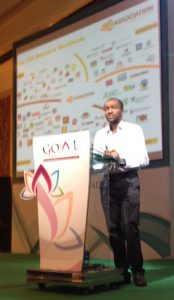 Thursday, Oct. 9, 9:15 a.m.—It’s always refreshing to add a non-seafood speaker to the program, forcing the aquaculture-dominated audience to take a step back and learn how another industry is dealing with the same types of challenges that aquaculture faces. George Watene of the 4C Association talked about the coffee industry’s “4C” approach to sustainability — smallholder engagement and industry collaboration are the pillars of the 4C model.
Thursday, Oct. 9, 9:15 a.m.—It’s always refreshing to add a non-seafood speaker to the program, forcing the aquaculture-dominated audience to take a step back and learn how another industry is dealing with the same types of challenges that aquaculture faces. George Watene of the 4C Association talked about the coffee industry’s “4C” approach to sustainability — smallholder engagement and industry collaboration are the pillars of the 4C model.
There are about 25 million small-scale coffee farmers worldwide.
“You’re not going to be able to use the same net to catch small fish that you use to catch big fish,” advised Watene in explaining the coffee industry’s approach to smallholder engagement.
Thursday, Oct. 9, 8:45 a.m.—Øistein Thorsen of Benchmark Sustainability Science—a New York-based firm that helps organizations design a comprehensive and strategic approach to sustainability through footprint and value-chain analysis — is at the podium, giving the keynote address. He made the business case for aquaculture, painting a bright yet cautious picture for the future of the industry.
“Everything is getting more scarce. We have a growing global middle class that’s rapidly changing their diet and putting immense pressure on the supply chain,” said Thorsen. “Yet there’s some good news for aquaculture. Your product is incredibly popular among the growing middle class in Asia, and no one can touch your feed-conversion ratios.”
Thorsen identified four major challenges that aquaculture needs to address if it’s to attract capital and investment — resource scarcity, climate change, transparency and the digital revolution, and consumer perception.
“We need to show we can do more with less,” said Thorsen. “We need to address climate change. We need to be transparent and embrace technology. And, finally, don’t be shy to tell your story.”
Thursday, Oct. 9, 8:00 a.m.—Back at it. Best Aquaculture Practices Standards Coordinator Dan Lee is at the podium. Lee moderated Tuesday’s aquafeed seminar, which featured a series of 13 presentations followed by a robust Q & A. More than 150 GOAL 2014 delegates filled the room.
After giving a recap of the seminar, Lee called Andrew Mallison of IFFO, Lukas Manomaitis of the U.S. Soybean Export Council, Ari Jadwin of Aquafude and Katrina Nakamura of Labor Screen Safe and Sustainability Incubator to the stage, where they answered a series of questions from the moderator and audience.
Scroll down for a full recap of the aquafeed seminar.
After the Q & A, the audience was asked, through the automatic response system, “What’s the No. 1 challenge facing aquafeed production?” One-third said environmental concerns associated with reduction and by-catch fisheries, and 30 percent said feed approached as a cost, not an investment. About 15 percent said lack of investment in alternative protein sources, while 12 percent said labor abuse aboard vessels in reduction and by-catch fisheries was the top issue. Eight percent said the lack of common requirements related to feed was the biggest challenge, and only 2 percent identified the use of GMOs as their top concern.
The audience was also asked, “Which sector needs to be held more accountable for the challenges facing aquafeed production?” Some 40 percent said feed manufacturers, 22 percent said aquaculture producers, and 15 percent each said government and feed fish fisheries.
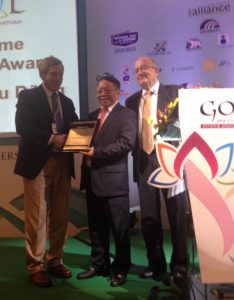 Wednesday, Oct. 8, 12:30 p.m.—After Mr. Le Van Quang, chairman and general director of Minh Phu Seafood Corp., gave a 30-minute presentation on the future of Vietnam’s seafood industry, Dr. Nguyen Huu Dzung accepted a Lifetime Achievement Award from GAA Executive Director Wally Stevens and GAA President George Chamberlain.
Wednesday, Oct. 8, 12:30 p.m.—After Mr. Le Van Quang, chairman and general director of Minh Phu Seafood Corp., gave a 30-minute presentation on the future of Vietnam’s seafood industry, Dr. Nguyen Huu Dzung accepted a Lifetime Achievement Award from GAA Executive Director Wally Stevens and GAA President George Chamberlain.
“No country, to my knowledge, has such a devoted ‘salesperson.’ He’s a truly special man,” said Stevens in introducing Dr. Dzung.
A humble Dr. Dzung accepted the award, and his acceptance speech was lighthearted and humorous. “I haven’t farmed any fish. My only direct association with aquaculture is eating a lot of fish,” he said, which elicited a laugh from the audience. “This award is not for me. It’s for Vietnam.”
Dzung’s career in seafood spans more than four decades. He is best known for his work with the Vietnam Association of Seafood Exporters and Producers. He became general secretary of VASEP upon its establishment in 1998 and currently acts as the organization’s vice president. In that time, Vietnam’s aquaculture industry has grown tremendously. In 2013, the country exported U.S. $6.72 billion of seafood, with shrimp and Pangasius exported to a total of 91 and 148 countries, respectively.
Wednesday, Oct. 8, 11:15 a.m.—Following the coffee break, Ragnar Tveteras of the University of Stavanger took the stage. A fixture of GAA’s GOAL conference, Tveteras summarized global finfish production figures. Again, data before 2012 is based on FAO data, while data after 2012 was collected by GAA Development Manager Darryl Jory, who surveys dozens of producers worldwide annually and provides the figures to Tveteras for analysis. Here’s what he found:
• Global tilapia production is growing. It’s projected to reach 4.5 million metric tons in 2014, 4.7 million metric tons in 2015 and nearly 5 million metric tons in 2016.
• Global Pangasius production is hovering at around 2 million metric tons, but it’s expected to edge up from around 2 million metric tons in 2014 to 2.1 million metric tons in 2015.
• It’s a similar story for catfish. Global catfish production, including Pangasius, is projected to remain flat at about 4 million metric tons from 2014 to 2015.
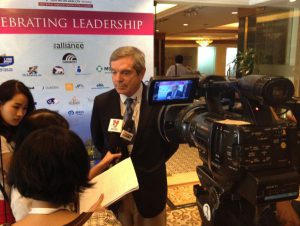 Wednesday, Oct. 8, 10:45 a.m.—A television news crew from Ho Chi Minh City (pictured at right) corralled GAA’s George Chamberlain during the coffee and tea break to interview him about early mortality syndrome management and the impacts of the disease on Vietnam’s shrimp industry. EMS and disease management were the focus topics for this morning’s presentations.
Wednesday, Oct. 8, 10:45 a.m.—A television news crew from Ho Chi Minh City (pictured at right) corralled GAA’s George Chamberlain during the coffee and tea break to interview him about early mortality syndrome management and the impacts of the disease on Vietnam’s shrimp industry. EMS and disease management were the focus topics for this morning’s presentations.
Wednesday, Oct. 8, 10:15 a.m. —A fixture of GAA’s GOAL conference, Jim Anderson of the World Bank presented global shrimp production figures for 2014. Data before 2012 is based on FAO data, while data after 2012 was collected by GAA Development Manager Darryl Jory, who surveys dozens of producers worldwide annually and provides the figures to Anderson for analysis.
Global shrimp production is projected to drop 19 percent from 2012 to 2013, but it’s expected to jump 18 percent from 2013 to 2014, said Anderson.
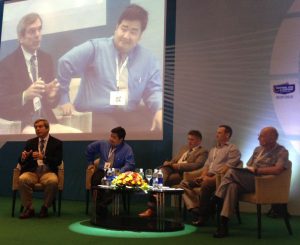 Wednesday, Oct. 8, 10:00 a.m.—After his keynote and 60-minute panel on early mortality syndrome (EMS) and disease management, GAA’s George Chamberlain polled the audience via the conference’s audience response system.
Wednesday, Oct. 8, 10:00 a.m.—After his keynote and 60-minute panel on early mortality syndrome (EMS) and disease management, GAA’s George Chamberlain polled the audience via the conference’s audience response system.
When asked to identify the most important tool for managing EMS, 37 percent said farm management, 30 percent said genetic resistance and 18 percent said hatchery management.
When asked how long it will take for shrimp farming to rebound from EMS, 33 percent said two years, 31 percent said three years and only 8 percent said one year.
Wednesday, Oct. 8, 9:30 a.m.—The preliminary results of GAA’s early mortality syndrome (EMS) survey are in.
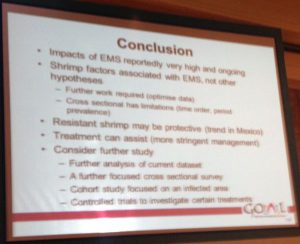 Brendan Cowled of AusVet Animal Health Services analyzed the preliminary results on behalf of GAA. There were 1,351 survey respondents, thanks mainly to Grobest, which urged its salespeople in the field to urge its farms to participate. The prevalence of EMS among survey respondents was 89.7 percent.
Brendan Cowled of AusVet Animal Health Services analyzed the preliminary results on behalf of GAA. There were 1,351 survey respondents, thanks mainly to Grobest, which urged its salespeople in the field to urge its farms to participate. The prevalence of EMS among survey respondents was 89.7 percent.
An encouraging trend is occurring in Mexico, said Cowled. “Resistant shrimp may be proactive,” he said. At right is a slide of conclusions from Cowled’s presentation.
Cowled sat on a panel with Tim Flegel of the Thai National Science and Technology Development Agency, who talked about improved diagnostic methods; Loc Tran of Minh Phu Aquamekong ShrimpVet Lab at Nong Lam University in Vietnam, who talked about management via polyculture; and Peter Marshall of R.S. Standards, who talked about zone management.
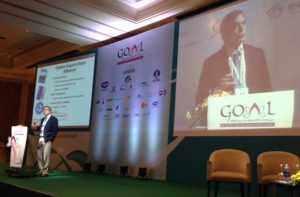 Wednesday, Oct. 8, 8:45 a.m.—In his 30-minute keynote address, GAA President George Chamberlain was the bearer of good news and bad news. First, the bad news. In the wake of early mortality syndrome, new diseases are already appearing in shrimp — microsporidean parasites and a new nodavirus called covert mortality nodavirus.
Wednesday, Oct. 8, 8:45 a.m.—In his 30-minute keynote address, GAA President George Chamberlain was the bearer of good news and bad news. First, the bad news. In the wake of early mortality syndrome, new diseases are already appearing in shrimp — microsporidean parasites and a new nodavirus called covert mortality nodavirus.
Now, the good news. “The battle against EMS is shifting from guessing what to do to implementing what works,” including surveillance with improved PCR tests, genetic resistance and biosecure hatcheries, said Chamberlain.
We will not grow aquaculture production without comprehensive disease management protocols, he explained. But these protocols are being employed. For example, deeper ponds with high yields—like the ones used in Pangasius farming in Vietnam—are being used in shrimp farming in China. Additionally, the industry is working more collaboratively that it ever has.
“The journey against disease management will never end, but we’re learning” from our mistakes, said Chamberlain.
Shrimp farming is poised to grow again, he added. Done sustainably, global shrimp production can double in the next 10 years, said Chamberlain.
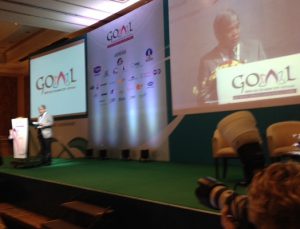 Wednesday, Oct. 8, 8:15 a.m.—Dr. Pham Anh Tuan is giving the welcoming address. Dr. Tuan (pictured at right) has been deputy director general at the Directorate of Fisheries of the Vietnam Ministry of Agriculture and Rural Development in Hanoi since 2010.
Wednesday, Oct. 8, 8:15 a.m.—Dr. Pham Anh Tuan is giving the welcoming address. Dr. Tuan (pictured at right) has been deputy director general at the Directorate of Fisheries of the Vietnam Ministry of Agriculture and Rural Development in Hanoi since 2010.
Wednesday, Oct. 8, 8:00 a.m.—GOAL 2014 is under way! The grand ballroom at the Sheraton Saigon Hotel and Towers is packed. About 425 GOAL 2014 delelgates are registered.
In his opening remarks, GAA Executive Director Wally Stevens added a seventh challenge to the six major challenges facing aquaculture—consumer education.The original five major challenges are health and disease management, feed, environmental and social accountability, investment capital and market support. At GOAL 2013, Stevens added leadership as the sixth major challenge — a challenge he emphasized yet again here in Ho Chi Minh City.
Somewhat surprisingly, via the conference’s audience response system, 13 percent of the audience selected “consumer education” as the No. 1 challenge facing aquaculture, despite the fact that Stevens had just introduced the challenge.
“The prize for all of us is the consumer,” said Stevens. “Collectively, that’s the prize we need to strive for.”
To no surprise, health and disease management garnered nearly half of the audience’s vote, given early mortality syndrome’s devastating effect on global shrimp production. GAA President George Chamberlain’s keynote is on EMS and disease management.
Tuesday, Oct. 7, 1:30 p.m.—Back from lunch. The next hour of this afternoon’s aquafeed seminar centers on the potential of alternative protein sources. Ari Jadwin of Aquafude, which is based in Chengdu, China, kicked it off with a presentation on the potential of insect meal as a feed ingredient and the production of trout, salmon and sturgeon, high-end fish species in western China.
The growth potential is enormous, said Jadwin. Annual per-capita seafood consumption in China is double the global average, about 40 kilograms. Trout, salmon and sturgeon are the fastest-growing segments of seafood consumption in China, and Chengdu is the fastest-growing city in the country.
However, “it would be easy to adopt bad practices” in western China, where commercial aquaculture is a relatively new industry. Aquafude works with farmers who buy the company’s high-quality feed, and, in turn, the farmers agree to sell the fish back to Aquafude. The company supplies the fish to high-end restaurants and hotels in western China.
“We have this platform to implement, and we want to do this in the fastest-growing part of China before the competition takes hold,” said Jadwin.
Tuesday, Oct. 7, 11:15 a.m.—Lukas Manomaitis of the U.S. Soybean Export Council (pictured at right) is at the podium. He talked about the need for a feed formulation database. Currently, there’s no such database in seafood, though there is for other proteins, such as beef and pork. USSEC is trying to commission the first such feed formulation database globally.
Tuesday, Oct. 7, 11:00 a.m.—After Libby Woodhatch, Katrina Nakamura of Labor Screen Safe and Sustainability Incubator address the social concerns associated with feed production. “This issue is already in the public consciousness,” she said. “It’s a worldwide problem.” Labor Screen Safe provides a risk-assessment program that can be incorporated into a company’s existing social responsibility policy.
Tuesday, Oct. 7, 10:45 a.m.—Libby Woodhatch of Seafish’s Responsible Fishing Scheme (RFS) is at the podium. A United Kingdom-based program, RFS currently encompasses entitlement to work, human rights, living remuneration, working hours, crew discrimination and life on board. The question now is, “How do we internationalize the standards?” said Woodhatch. “We have to have global aspirations.”
“How would it work?” she asked. “The key will be whether a country will use its existing compliance or whether its compliance will need to be benchmarked.”
What’s the timeline? A certification body with international expertise has been appointed. In March 2015, the first vessels in the U.K. are expected to be certified against the standards, with an international launch anticipated in September 2015. “We need to make sure that the standards are ready for international use,” said Woodhatch.
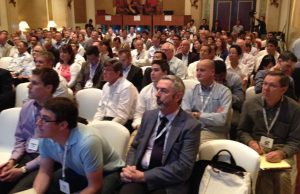 Tuesday, Oct. 7, 10:00 a.m.—”There is a link between poor fisheries management and poor social welfare — they go hand in hand,” said Dan Lee of the Global Aquaculture Alliance’s Best Aquaculture Practices division, as Tuesday’s discussion shifted from environmental to social concerns.
Tuesday, Oct. 7, 10:00 a.m.—”There is a link between poor fisheries management and poor social welfare — they go hand in hand,” said Dan Lee of the Global Aquaculture Alliance’s Best Aquaculture Practices division, as Tuesday’s discussion shifted from environmental to social concerns.
Tuesday, Oct. 7, 9:45 a.m.—”It’s impressive to see so many people in the room. Feed was always so far removed from the sustainability discussion, particularly with the marketplace. By the faces I see in the room, it shows how different things are today,” said Andrew Mallison of IFFO, at the start of his 15-minute presentation on fishmeal and fish oil.
Mallison recognized that a lot more work needs to be done with the multi-species trawl fisheries and the social component of reduction and by-catch fisheries, where labor abuse is a major concern. There is not enough synergy between environmental and social third-party audits, he acknowledged.
Tuesday, Oct. 7, 9:30 a.m.—Anton Immink of the Sustainable Fisheries Partnership followed Dawn Purchase with an update on SFP’s work with fishery improvement projects (FIPs) in feed fish fisheries and the Asian Feed Fisheries Supplier Roundtable.
Immink talked a lot about environmental concerns. When asked about the social concerns associated with reduction and by-catch fisheries, Immink explained that the industry is still years away from certification at the fisheries level, though all sectors of the industry are actively working on a solution.
“We’re looking at how social issues can be included in the process,” said Immink. “But we’re still on a five-year timeline. Certification is certainly five years away. I wouldn’t put a shorter timeframe on it.”
Tuesday, Oct. 7, 9:15 a.m.—Further setting the scene, Dawn Purchase of the Marine Conservation Society challenged the audience to be part of the solution: “There is nowhere left to go. We need to ensure the sustainable management of wild fisheries to ensure [the growth of aquaculture]. We will hear from IFFO and the Sustainable Fisheries Partnership on how this can and will be addressed. I would urge everyone in the supply chain to act responsibility by contributing in whatever way you can.”
Tuesday, Oct. 7, 9:00 a.m.—Tuesday’s aquafeed seminar is under way. There are about 150 GOAL 2014 delegates in attendance! Chinese, Thai and Vietnamese translations are available.
Best Aquaculture Practices Standards Coordinator Dan Lee kicked off the seminar by setting the scene. He explained that the purpose of the seminar is to address the environmental and social concerns associated with feed production, gauge the potential of alternative protein sources and contemplate the need to approach feed as an investment, not as a cost.
Monday, Oct. 6, 8:00 p.m.— Ballroom 3 at the Park Hyatt Saigon — the venue of Tuesday’s aquafeed seminar — is coming together nicely.
A big thanks to Grobest, Cargill, the U.S. Soybean Export Council and Soy Aquaculture Alliance, and National Renderers Association for sponsoring the seminar, which starts at 9 a.m. BAP Standards Coordinator Dan Lee is moderating the seminar, featuring 13 presentations and 75 minutes of Q&A and discussion. Aquafeed sustainability is one of the major themes of GOAL 2014.
Monday, Oct. 6, 3:00 p.m.—Eighteen hours and counting. Delegates are filling up the Sheraton Saigon Hotel & Towers, as final preparations are being made for tomorrow’s conference, which officially kicks off with a day-long seminar dedicated to aquafeed sustainability.
An impressive list of presenters are lined up to discuss the future of feed: Dan Lee, Best Aquaculture Practices; Dawn Purchase, Marine Conservation Society; Anton Immink, Sustainable Fisheries Partnership; Andrew Mallison, IFFO; Libby Woodhatch, Seafish Responsible Fishing Scheme; Katrina Nakamura, Labor Screen Safe, Sustainability Incubator; Lukas Manomaitis, U.S. Soybean Export Council; Steve Hart, Soy Aquaculture Alliance; Richard Smullen, Ridley Aqua-Feed, World Renderers Organization; Ari Jadwin and John Kilpatrick, AquaFude; Franck Ducharne, Entofood; Johannes Pucher and Ulfert Focken, Life Science Center of the University of Hohenheim; Francisco Olbrich, H.J. Baker; and George Chamberlain, Global Aquaculture Alliance.
Here’s the latest GOAL 2014 conference program: 2014program10-3-2014
Sunday, Oct. 5, 2:00 p.m.—Remember to visit the Apple app store or Google app store on your mobile device to download the GOAL 2014 app, featuring the latest program schedule, schedule of social and networking events, tour schedule, speaker profiles, sponsor profiles, hotel floor plans, maps and more. It’s your ticket to navigating the four-day conference at the Sheraton Saigon Hotel & Towers and Park Hyatt Saigon.
A PDF of the GOAL 2014 program can also be found here: 2014program10-3-2014
Sunday, Oct. 5, 9:00 a.m.—Greetings from Ho Chi Minh City, Vietnam!
 GAA’s GOAL 2014 conference kicks off in 48 hours. Delegates are begining to arrive at the Sheraton Saigon Hotel & Towers. More than 400 delegates — including 50-plus speakers — are expected to attend the four-day conference.
GAA’s GOAL 2014 conference kicks off in 48 hours. Delegates are begining to arrive at the Sheraton Saigon Hotel & Towers. More than 400 delegates — including 50-plus speakers — are expected to attend the four-day conference.
It’s a relatively quiet day. GAA’s Standards Oversight Committee is meeting today, but the conference doesn’t pick up until tomorrow, with a tour of Stapimex shrimp farm and processing plant in Soc Trong province. The conference officially kicks off on Tuesday with a day-long seminar dedicated to aquafeed sustainability. Sixteen presenters are lined up to discuss the future of feed, the environmental and social concerns associated with feed production and the potential of alternative protein sources. The seminar is being held at the Park Hyatt Saigon — a short walk from the Sheraton Saigon — from 9 a.m. to 4 p.m.
Here’s what else to expect this week:
• On Day 1, GAA President George Chamberlain is leading a 90-minute discussion on early mortality syndrome (EMS) and disease risk managment. The discussion features Tim Flegel of the National Science and Technology Development Agency, Peter Marshal of R.S. Standards, Loc Tran of Minh Phu Aquamekong ShrimpVet Lab at Nong Lam University and Brendan Cowled of AusVet Animal Health Services. Chamberlain is also leading a two-hour breakout on EMS and disease risk management from 3 to 5 p.m.
• Also on Day 1, Dr. Nguyen Huu Dzung, vice president of the Vietnam Association of Seafood Exporters and Producers, is being recognized with GAA’s Lifetime Achievement Award. The Vietnamese seafood champion will accept the award at 12:30 p.m.
• Also being recognized at GOAL 2014 is the winner of GAA’s Preferred Freezer Services Global Aquaculture Innovation & Leadership Award. The winner will be unveiled at 11:30 a.m. on Day 2.
• One of the themes of Day 2 is smallholder engagement and marketplace accessibility. George Watene of the 4C Association, Ted van der Put of IDH, Anton Immink of the Sustainable Fisheries Partnership and Jeff Sedacca of National Fish and Seafood Inc. are addressing the engagement of small-scale farmers.
• A three-hour seminar titled “Celebrating Vietnam” is being held in the ballroom of the Sheraton Saigon on Oct. 9 from 2 to 5 p.m., in recognition of Vietnam’s aquaculture industry. The seminar is free and open to GOAL and non-GOAL attendees.
• BAP V.P. of Market Development Peter Redmond has assembled many of the world’s leading seafood retailers and foodservice operators to discuss the challenges facing aquaculture. A total of five question-and-answer roundtables are scheduled — one on Day 2 and four on Day 3. It’s a once-a-year opportunity to hear firsthand from retail and foodservice heavyweights such as Walmart/Sam’s Club, Tesco, Delhaize, Sainsbury’s, Morrisons, Long John Silver’s and Red Lobster Seafood Co.

